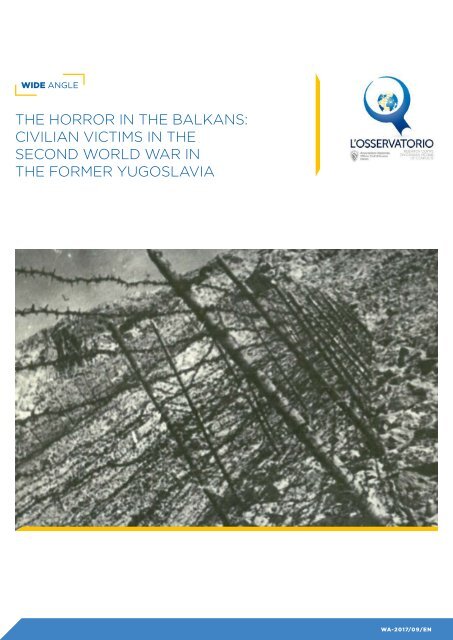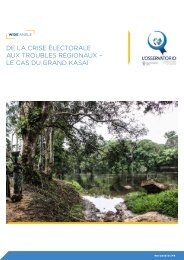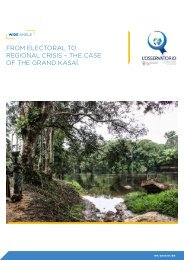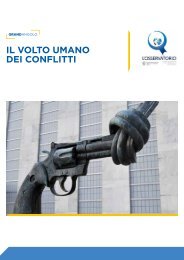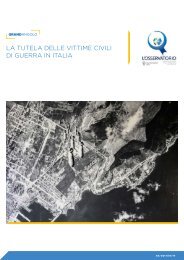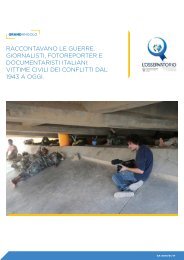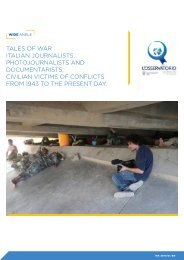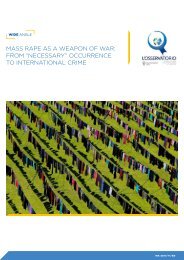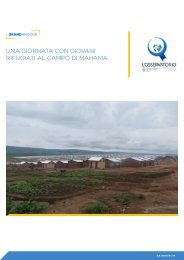The Horror in the Balkans. Civilian Victims in the Second World War in the Former Yugoslavia
You also want an ePaper? Increase the reach of your titles
YUMPU automatically turns print PDFs into web optimized ePapers that Google loves.
THE HORROR IN THE BALKANS:<br />
CIVILIAN VICTIMS IN THE<br />
SECOND WORLD WAR IN<br />
THE FORMER YUGOSLAVIA<br />
WA-2017/09/EN1
Author: Fiorella Perrone<br />
University of Salento<br />
Translator: Alessandro Lira<br />
Edit<strong>in</strong>g: Aditya Daga (UN onl<strong>in</strong>e volunteers)<br />
Graphic design: Vilmar Luiz (UN onl<strong>in</strong>e volunteer)<br />
Cover picture: A prison camp on Pag Island by Padre Paol<strong>in</strong>o Beltrame Quattrocchi,<br />
cappellano militare.<br />
Copyright © 2017<br />
L’Osservatorio – Research Centre on <strong>Civilian</strong> <strong>Victims</strong> of Conflict<br />
Via Marche, 54<br />
00187 Rome – Italy<br />
For fur<strong>the</strong>r <strong>in</strong>formation and comments please contact:<br />
@OsservatorioOrg<br />
losservatorio.org<br />
<strong>in</strong>fo@losservatorio.org<br />
This research paper is an <strong>in</strong>dependent publication commissioned by L’Osservatorio.<br />
<strong>The</strong> analyzes, conclusions and recommendations expressed <strong>in</strong> this document do not<br />
necessarily reflect <strong>the</strong> official position of L’Osservatorio. <strong>The</strong> material of <strong>the</strong> text can<br />
be freely reproduced with proper citation and/or attribution to <strong>the</strong> author and editor.<br />
2
Dur<strong>in</strong>g <strong>the</strong> course of <strong>the</strong> second world war, more than 900 thousand civilians perished <strong>in</strong><br />
<strong>Yugoslavia</strong> dur<strong>in</strong>g its <strong>in</strong>vasion by <strong>the</strong> Axis powers.<br />
Between 1941 and 1945, persecutions and massacres of unprecedented ferocity had undertaken<br />
on <strong>the</strong> Yugoslav soil, expressly directed aga<strong>in</strong>st <strong>the</strong> civilian population.<br />
With this paper it is analysed, through sources and testimonies published and unpublished,<br />
<strong>the</strong> period that goes from April 1941 to September 1943 <strong>in</strong> <strong>the</strong> area <strong>in</strong>terested by <strong>the</strong> Italian<br />
occupation. More precisely, <strong>the</strong> brutal actions aga<strong>in</strong>st <strong>the</strong> Serbs, Jews and Rom populations<br />
from <strong>the</strong> Croatian regime, <strong>the</strong> NDH (Nezavisna Država Hrvatska, Independent State of<br />
Croatia) placed under Italian <strong>in</strong>fluence and entrusted to <strong>the</strong> leader of <strong>the</strong> party Ustaša Ante<br />
Pavelić, and war crimes for which it has scorched <strong>the</strong> Italian army <strong>in</strong> <strong>the</strong> territories under its<br />
control are retraced through this paper.<br />
If a veritable carnage was consumed by militias Ustaša, made of massacres, torture, deportations<br />
with racial and religious nature, aimed at “ethnic cleans<strong>in</strong>g” of <strong>the</strong>ir boundaries, <strong>the</strong><br />
cruelty which was used by <strong>the</strong> Italian troops, on <strong>the</strong> basis of directives which codified retaliation<br />
as a massive <strong>in</strong>strument of persuasion and punishment of civilians; <strong>the</strong> rak<strong>in</strong>g and<br />
<strong>the</strong> mass <strong>in</strong>ternment which <strong>in</strong>volved <strong>in</strong>dist<strong>in</strong>ctly men, women, children and <strong>the</strong> elderly – as<br />
means to “depopulate and devastate entire regions”, was not less, accord<strong>in</strong>g to <strong>the</strong> conclusions<br />
reached by <strong>the</strong> Commission of State for <strong>in</strong>vestigations on crimes of <strong>the</strong> occupants<br />
(Belgrade, 1946).<br />
Events that had been removed for a long time and still poorly known to <strong>the</strong> general public,<br />
have been reconstructed here through <strong>the</strong> analysis of <strong>the</strong> most salient historical passages<br />
and <strong>the</strong> survivor’s story.<br />
Keywords: second world war, former <strong>Yugoslavia</strong>, ethnic cleans<strong>in</strong>g, nazi fascism, civilian victims,<br />
Italian occupation, Ustaša<br />
3
Summary<br />
<strong>The</strong> conflict <strong>in</strong> <strong>the</strong> <strong>Balkans</strong> and <strong>the</strong> Italian occupation...................................................... 5<br />
<strong>The</strong> Croatian regime of Ustaša................................................................................................. 7<br />
<strong>The</strong> witness of <strong>the</strong> Italian military chapla<strong>in</strong>........................................................................... 9<br />
<strong>The</strong> Italian Crimes.......................................................................................................................13<br />
Endnotes.......................................................................................................................................19<br />
4
<strong>The</strong> conflict <strong>in</strong> <strong>the</strong> <strong>Balkans</strong> and <strong>the</strong> Italian occupation<br />
<strong>The</strong> second world war arrived <strong>in</strong> <strong>Yugoslavia</strong> on 6th April 1941. On that date, on <strong>the</strong> eve<br />
of Palm Sunday, <strong>the</strong> German army moved <strong>the</strong> attack <strong>in</strong> just 11 days and affirmed <strong>the</strong><br />
conquest of <strong>the</strong> k<strong>in</strong>gdom by <strong>the</strong> Axis forces.<br />
<strong>The</strong> Italians <strong>in</strong>vaded <strong>the</strong> Dalmatian coast and occupied Ljubljana on <strong>the</strong> 11th of April.<br />
On <strong>the</strong> 17th, <strong>the</strong> high command of <strong>Yugoslavia</strong> surrendered.<br />
<strong>The</strong> division of <strong>the</strong> <strong>in</strong>vaded lands, which shattered <strong>Yugoslavia</strong> politically as well as<br />
militarily, was as quick as <strong>the</strong> enemy progression.<br />
Italy claimed part of Slovenia and annexed Dalmatia, from Zadar to Split, as well as a<br />
protectorate on Montenegro, Kosovo and <strong>the</strong> western Macedonia. In <strong>the</strong>se territories<br />
lived, <strong>in</strong> different proportions and precarious equilibrium, Slovenes, Croats, Serbs, Italians,<br />
Montenegr<strong>in</strong>s, Albanians and Macedonians, toward which were applied policies<br />
of fascist <strong>in</strong>doctr<strong>in</strong>ation and attempts of denationalisation. 1 <strong>The</strong> rema<strong>in</strong><strong>in</strong>g part of <strong>the</strong><br />
Yugoslav territories were divided between Germany, Bulgaria and Hungary. F<strong>in</strong>ally,<br />
<strong>the</strong> Independent State of Croatia (NDH – Nezavisna Država Hrvatska) was created,<br />
<strong>in</strong>clud<strong>in</strong>g Croatia-Slavonia and Bosnia and Herzegov<strong>in</strong>a (that was occupied <strong>in</strong> <strong>the</strong><br />
summer of 1941 by <strong>the</strong> Italian army) and some Dalmatian islands (Pag, Barc and Hvar).<br />
In this way <strong>the</strong> fascist government fulfilled its expansionist <strong>in</strong>tents on <strong>the</strong> Balkan’s territories,<br />
<strong>the</strong> same that was precluded at <strong>the</strong> end of <strong>the</strong> first world war and that had allowed<br />
Mussol<strong>in</strong>i to feed <strong>the</strong> myth of <strong>the</strong> “mutilated victory”. <strong>The</strong> regime’s propaganda<br />
had s<strong>in</strong>ce <strong>the</strong>n encouraged a revisionist political action that focused on <strong>the</strong> return of<br />
what Italy “legitimately” deserved: or ra<strong>the</strong>r, us<strong>in</strong>g a s<strong>in</strong>ister analogy to Nazi vocabulary,<br />
what was def<strong>in</strong>ed as Italian “vital space” on <strong>the</strong> eastern borders. 2 In order to claim<br />
that legitimacy, racial motivations were associated with historical and geopolitical<br />
reasons. “Italy is <strong>the</strong> only Mediterranean country of <strong>the</strong> Aryan race. This is enough to<br />
expla<strong>in</strong> to anyone who has a culture, that it naturally possesses a prom<strong>in</strong>ent position<br />
<strong>in</strong> <strong>the</strong> Great Internal Sea”. 3 – wrote Giovanni Ansaldo <strong>in</strong> January 1941.<br />
In 1941 Italy, supported by <strong>the</strong> powerful German ally, benefited from a position of<br />
supremacy <strong>in</strong> <strong>the</strong> occupied territories <strong>in</strong> <strong>the</strong> <strong>Balkans</strong>. In <strong>the</strong>se zones, civilians were<br />
mistreated with violence. At <strong>the</strong> same time a process of strong “Italianization” of <strong>the</strong><br />
population started. This process was even more pa<strong>in</strong>ful for <strong>the</strong> orig<strong>in</strong>al population<br />
because it had been perpetrated by <strong>the</strong>ir worst enemy, <strong>the</strong> fascist regime, ally of <strong>the</strong><br />
Croatian nationalism of Ustaša, who <strong>in</strong> <strong>the</strong> year 1934 committed <strong>the</strong> murder of K<strong>in</strong>g<br />
Alexander I <strong>in</strong> Marseilles. 4<br />
“Here <strong>in</strong> Dalmatia, <strong>in</strong> Split – told Lovre Reić, Croatian partisan, who was fourteen at<br />
<strong>the</strong> time of <strong>the</strong> conflict – “we have always been told that <strong>the</strong> Italians were our enemies.<br />
When I heard <strong>the</strong> news of <strong>the</strong> murder of K<strong>in</strong>g Alexander, I came out of my house<br />
with a knife to go <strong>in</strong> search of a young boy belong<strong>in</strong>g to an Italian wire family; I wanted<br />
to take revenge on him for <strong>the</strong> assass<strong>in</strong>ation of our k<strong>in</strong>g. I didn’t even know what a<br />
k<strong>in</strong>gdom or a social system was, but he was <strong>the</strong> k<strong>in</strong>g of my country and our enemies,<br />
<strong>the</strong> Italians, had killed him”. He was a young man named Pige, who played football<br />
5
Soldiers pose with children <strong>in</strong> <strong>the</strong> area occupied by Italian forces.<br />
Credit: Padre Paol<strong>in</strong>o Beltrame Quattrocchi, cappellano militare.<br />
and belonged to an Italian wire family”. 5 <strong>The</strong>se few words syn<strong>the</strong>tically testify, <strong>the</strong><br />
violence that was caused by <strong>the</strong> <strong>in</strong>vader’s occupation and <strong>the</strong> primordial barbarism<br />
that <strong>the</strong> act of war produced generat<strong>in</strong>g sides and divisions, which enter conflict<strong>in</strong>gly<br />
<strong>in</strong>to <strong>the</strong> life of <strong>the</strong> local community, modify<strong>in</strong>g <strong>the</strong> social balance.<br />
“<strong>The</strong> mistrust and hostility towards Italy is still nourished as confirmed <strong>in</strong> 1940 by <strong>the</strong><br />
Italian military attached <strong>in</strong> Belgrade – that it is often concealed but it came out <strong>in</strong> <strong>the</strong><br />
daily conversations. <strong>The</strong> story returns to circulate quite often that Italy wants to claim<br />
back part of Dalmatia and Sou<strong>the</strong>rn Serbia. Driven by <strong>the</strong> bl<strong>in</strong>dness of hatred for Italians,<br />
many people declared that it would be better if <strong>the</strong> Russians came and that it<br />
would be better than <strong>the</strong> Italian doma<strong>in</strong>!”. 6<br />
“<strong>The</strong> hardest th<strong>in</strong>g that could happen psychologically, at that time – expla<strong>in</strong>ed Reić, recall<strong>in</strong>g<br />
<strong>the</strong> days of <strong>the</strong> <strong>in</strong>vasion <strong>in</strong> April 1941 – was that <strong>the</strong> Italians arrived. […] When <strong>the</strong>y<br />
arrived, wear<strong>in</strong>g black shirts, you can imag<strong>in</strong>e how disgust<strong>in</strong>g and unacceptable it was”.<br />
Reić, who was 20 at that time, had a very different maturity of observation and action<br />
from that of Slvako Degoricija, 10 years old at that time, whose witness allows us to<br />
<strong>in</strong>vestigate <strong>the</strong> specificity and complexity of <strong>the</strong> impact of war on children:<br />
“I remember <strong>the</strong> day when Yugoslav surrendered. It was Easter Sunday 1941, an Italian<br />
Division came to Otočac from Rijeka (Fiume). For us children it was like a miracle.<br />
Tanks, military vehicles, soldiers <strong>in</strong> uniform. We were return<strong>in</strong>g from <strong>the</strong> church,<br />
and when we saw <strong>the</strong>m, we stopped to acknowledge <strong>the</strong>m […] my fa<strong>the</strong>r suddenly<br />
appeared and began to shout at us, say<strong>in</strong>g that we should be ashamed for hav<strong>in</strong>g<br />
acknowledged <strong>the</strong> occupants. And he hit me. It was <strong>the</strong> only time he ever hit me. […]<br />
I did not even know what <strong>the</strong> words occupant and stranger meant. This is my first<br />
memory of <strong>the</strong> <strong>Second</strong> <strong>World</strong> <strong>War</strong>.<br />
6
<strong>The</strong> Italians set up bil<strong>in</strong>gual signs <strong>in</strong> Otočac. Older kids, who attended high school,<br />
told us to tear <strong>the</strong>m down and we did it at night. We were children, we didn’t understand,<br />
we took it for a joke. <strong>The</strong> next morn<strong>in</strong>g, <strong>the</strong> Italian police came at school, <strong>the</strong>y<br />
had lea<strong>the</strong>r whips, approximately one meter long, to hit us. We began to run, just near<br />
<strong>the</strong> school <strong>the</strong>re was <strong>the</strong> river Gacka, it was late autumn, even though <strong>the</strong> water was<br />
freez<strong>in</strong>g, I threw myself <strong>in</strong>to it. <strong>The</strong> whip hit me anyway, along my whole body, from<br />
<strong>the</strong> shoulder to <strong>the</strong> heel. I threw myself <strong>in</strong> <strong>the</strong> frozen river and <strong>the</strong>n ran home. […] So<br />
we learned how to live with <strong>the</strong> war as children. We learned how to endure. While our<br />
region was occupied, <strong>the</strong> German airplanes bombed us, <strong>the</strong> British airplanes bombed<br />
us, even <strong>the</strong> partisans bombed us.” 7<br />
For a child is difficult, if not impossible, to understand war and that leaves permanent<br />
signs. <strong>The</strong> confusion that it generates is amplified by childish imag<strong>in</strong>ation. Firstly,<br />
<strong>the</strong> game is confused with <strong>the</strong> reality, miss<strong>in</strong>g any awareness or maturity needed to<br />
be able to clarify <strong>the</strong> events surround<strong>in</strong>g <strong>the</strong>m, children are fasc<strong>in</strong>ated by what <strong>the</strong>y<br />
should fear or hate and, on <strong>the</strong> contrary, are frightened or traumatized by m<strong>in</strong>or episodes.<br />
It is not a case that Degoricija concludes by say<strong>in</strong>g:<br />
“People often ask me how I managed to withstand <strong>the</strong> civil war [which has bloodied<br />
<strong>the</strong> <strong>Balkans</strong> dur<strong>in</strong>g <strong>the</strong> n<strong>in</strong>eties]. I answered say<strong>in</strong>g that, I crossed far more difficulties<br />
when I was a child. <strong>The</strong> period from 1941 to 1945 was much harder than <strong>the</strong> civil war”.<br />
<strong>The</strong> Croatian regime of Ustaša<br />
On <strong>the</strong> 18th of May, one month after <strong>the</strong> <strong>in</strong>vasion, Italo-Croats agreements were concluded<br />
with <strong>the</strong> creation of an Italian protectorate on <strong>the</strong> NDH. <strong>The</strong> Independent<br />
State of Croatia, whose creation was supported by <strong>the</strong> Nazi-Fascist forces <strong>in</strong> order to<br />
facilitate <strong>the</strong> process of dis<strong>in</strong>tegration of <strong>Yugoslavia</strong> 8 and especially <strong>the</strong> political and<br />
territorial union of <strong>the</strong> Serb nation, <strong>in</strong>cluded not only Croatia but also a large part of<br />
<strong>the</strong> Bosnia and Herzegov<strong>in</strong>a where <strong>the</strong>re were more than one million and a half Serbs<br />
and half a million Muslims. S<strong>in</strong>ce <strong>the</strong> beg<strong>in</strong>n<strong>in</strong>g, <strong>the</strong> new established government was<br />
characterised with crimes aga<strong>in</strong>st ethnic and religious m<strong>in</strong>orities.<br />
Ante Pavelić, <strong>the</strong> leader of <strong>the</strong> fascist and National Socialist <strong>in</strong>spired party of Ustaša,<br />
who returned from a long exile <strong>in</strong> Italy, proclaimed himself poglavnik (leader of Croats).<br />
He <strong>the</strong>n started a violent policy of “Croatization”, <strong>in</strong> addition to <strong>the</strong> rules designed<br />
to underm<strong>in</strong>e <strong>the</strong> Serbian identity, such as <strong>the</strong> abolition of <strong>the</strong> use of <strong>the</strong><br />
Cyrillic alphabet and <strong>the</strong> purification of <strong>the</strong> national offices, he enacted racial laws<br />
aga<strong>in</strong>st Jews and Gypsies. 9 <strong>The</strong> escalation that saw those rules degenerate, unleash<strong>in</strong>g<br />
a terrible spiral of horror and death, was dramatically short.<br />
<strong>The</strong> secular ethnic and religious rivalry and hatred, which <strong>the</strong> racial laws already re<strong>in</strong>forced<br />
with legal support <strong>in</strong> <strong>the</strong> countries which were allies of <strong>the</strong> axis forces, were<br />
l<strong>in</strong>ked with <strong>the</strong> policy of power, <strong>in</strong>fluenced by strategic, military and economic <strong>in</strong>terests<br />
and aimed to obta<strong>in</strong> an unchallenged doma<strong>in</strong> through <strong>the</strong> repression of any<br />
form of opposition. This purpose was already clear <strong>in</strong> 1940 through <strong>the</strong> words of <strong>the</strong><br />
7
Old men, women and children kept and deported.<br />
Credit: Padre Paol<strong>in</strong>o Beltrame Quattrocchi, cappellano militare.<br />
Italian Consul <strong>in</strong> Zagreb. In his speech, describ<strong>in</strong>g <strong>the</strong> political situation of <strong>the</strong> foreign<br />
m<strong>in</strong>ister Ciano <strong>in</strong> <strong>Yugoslavia</strong>, he highlighted how “<strong>the</strong> Jewish element, which has an<br />
important economic status quo <strong>in</strong> Croatia, […] has always supported <strong>the</strong> Serbians <strong>in</strong><br />
order to weaken <strong>the</strong> economic positions of Croatia and consequently <strong>the</strong> nationalization<br />
process” 10 , so it was important to “expel <strong>the</strong> freemasons and Jews that polluted<br />
our whole policy”. 11<br />
<strong>The</strong> Ustaša promoted violence aga<strong>in</strong>st <strong>the</strong> national m<strong>in</strong>orities of Serbian-orthodox,<br />
Jews and Rom, us<strong>in</strong>g massive and systematic ethnic cleans<strong>in</strong>g, implemented through<br />
<strong>the</strong> physical removal of a part of <strong>the</strong> civil population, with hundreds of thousands of<br />
victims, <strong>the</strong> deportation of <strong>the</strong> survivors, <strong>the</strong> forced conversion to Catholicism. 12 Of<br />
<strong>the</strong> approximately twenty concentration camps established, <strong>the</strong> camps that sadly rema<strong>in</strong>ed<br />
are <strong>the</strong> famous ones of Slano, on <strong>the</strong> island of Pag, and <strong>the</strong> Jasenovac, where<br />
around 120 thousand people lost <strong>the</strong>ir lives. 13<br />
To escape persecution, <strong>the</strong> Serbs did not hesitate to ask for help from <strong>the</strong> Italians.<br />
<strong>The</strong>se were moved from <strong>the</strong> necessity to counteract <strong>the</strong> alliance between <strong>the</strong> Germans<br />
and <strong>the</strong> Ustaša, potentially harmful for <strong>the</strong> control of <strong>the</strong> territory. Protection was also<br />
offered to part of <strong>the</strong> Jews escap<strong>in</strong>g from <strong>the</strong> Nazis and Croats massacres. 14<br />
From this aspect, it appears <strong>in</strong>terest<strong>in</strong>g a document of <strong>the</strong> end of 1943, requested by<br />
<strong>the</strong> Italian Military Ord<strong>in</strong>ariate, <strong>in</strong> which <strong>the</strong> military chapla<strong>in</strong> Cesare Beltrame Quattrocchi,<br />
operat<strong>in</strong>g <strong>in</strong> <strong>the</strong> 27th sector and <strong>the</strong>n <strong>in</strong> <strong>the</strong> 5th Group<strong>in</strong>g guard at <strong>the</strong> border<br />
from April 1941, described <strong>in</strong> great detail, <strong>the</strong> many cases of violence perpetrated by<br />
<strong>the</strong> forces of <strong>the</strong> NDH <strong>in</strong> <strong>the</strong> region of Lika. Entire families, young and old people, children<br />
were massacred and burned down, while <strong>the</strong> survivors, wounded or mutilated,<br />
tried to escape and looked for rescue <strong>in</strong> <strong>the</strong> Italian military hospitals. 15<br />
8
<strong>The</strong> witness of <strong>the</strong> Italian military chapla<strong>in</strong><br />
“<strong>The</strong> night of 15 August 1941, toge<strong>the</strong>r with two medical officers and four armed<br />
men, we entered <strong>in</strong> <strong>the</strong> woods at <strong>the</strong> foot of <strong>the</strong> Velebit Mounta<strong>in</strong>, a zone controlled<br />
by Ustaša. We headed to an isolated house <strong>in</strong>dicated to us by a Chetniks,<br />
guided by a Serbian woman masquerad<strong>in</strong>g as an Italian soldier. We knocked at <strong>the</strong><br />
door, without anyone answer<strong>in</strong>g. After about half an hour <strong>the</strong> woman went <strong>in</strong> <strong>the</strong><br />
woods and returned accompanied by a liv<strong>in</strong>g skeleton, an exhausted and hungry<br />
man. He spoke a few words through <strong>the</strong> w<strong>in</strong>dow and <strong>the</strong> door opened. An unbearable<br />
stench fell upon us: on <strong>the</strong> floor a terrified woman and three children laid<br />
without say<strong>in</strong>g a word. <strong>The</strong> woman, Serbian, had been hit ten days before by <strong>the</strong><br />
gun of an Ustaša member, while carry<strong>in</strong>g her baby on <strong>the</strong> breast walk<strong>in</strong>g through<br />
<strong>the</strong> fields. <strong>The</strong> baby had died and she had a broken femur and a perforated lung.<br />
She was liv<strong>in</strong>g for ten days hermetically sealed <strong>in</strong> that room with <strong>the</strong> o<strong>the</strong>r babies<br />
under <strong>the</strong> nightmare of terror, she emanated an <strong>in</strong>tolerable stench. That face now<br />
furrowed by death […] was loaded on a stretcher and transported at <strong>the</strong> military<br />
hospital of Otocac under <strong>the</strong> fire of <strong>the</strong> Ustaša. […]<br />
From statistical data <strong>in</strong> possession of <strong>the</strong> command of <strong>the</strong> 2nd army <strong>in</strong> September<br />
1941, victims of <strong>the</strong> carnage of <strong>the</strong> Ustaša exceeded one hundred thousand. In December<br />
of <strong>the</strong> same year it had reached half a million. <strong>The</strong>se rumours were circulat<strong>in</strong>g <strong>in</strong><br />
<strong>the</strong> official circles of our commands. […] As far as I am about to expose, reflect<strong>in</strong>g my<br />
own personal experience <strong>in</strong> a limited and restricted sector, it is easy to imag<strong>in</strong>e <strong>the</strong><br />
immense abyss of hatred and bloodshed dug by <strong>the</strong> same Balkan peoples <strong>in</strong> <strong>the</strong>ir own<br />
land <strong>in</strong> <strong>the</strong> space of a few months from summer of 1941.<br />
Ustaša law acknowledges <strong>the</strong> exterm<strong>in</strong>ation of <strong>the</strong> Serbs and <strong>the</strong> oppression of <strong>the</strong><br />
Jews. From what I saw with my own eyes and heard with my own ears, <strong>the</strong> Croatians<br />
A man shot to death <strong>in</strong> <strong>the</strong> countryside <strong>in</strong> <strong>the</strong> area occupied by Italian forces.<br />
Credit: Padre Paol<strong>in</strong>o Beltrame Quattrocchi, cappellano militare.<br />
9
of Pavelić have killed thousands of Serbs of any sex or age, even <strong>in</strong>fants on <strong>the</strong>ir<br />
mo<strong>the</strong>r’s breasts for only one reason: because <strong>the</strong>y were Serbs.<br />
On <strong>the</strong> morn<strong>in</strong>g of 1st August 1941, <strong>in</strong> <strong>the</strong> early hours of dawn <strong>in</strong> Gospic (capital of <strong>the</strong><br />
prov<strong>in</strong>ce <strong>in</strong> <strong>the</strong> region of Lika), I was awakened by gunfire and clamours. At <strong>the</strong> periphery<br />
of <strong>the</strong> village a house burns: a house of Serbs. <strong>The</strong> Ustaša broke <strong>in</strong>to night and have<br />
sown this dismay and death. In <strong>the</strong> entrance laid half carbonized and twisted by <strong>the</strong><br />
flames, <strong>the</strong> corpses of two children, a boy and a girl around ten years (photo). Accompanied<br />
by some officers of <strong>the</strong> regiment, I entered through <strong>the</strong> scorch<strong>in</strong>g ru<strong>in</strong>s of <strong>the</strong><br />
destroyed house. In <strong>the</strong> only room saved by <strong>the</strong> flames I found a surprise: a cradle with<br />
a baby, few months old cry<strong>in</strong>g <strong>in</strong>side. It seems a wonder that among so much ru<strong>in</strong>s, an<br />
<strong>in</strong>nocent creature survived. We went closer to <strong>the</strong> cradle, we caressed <strong>the</strong> child who revealed<br />
two tired eyes. We th<strong>in</strong>k that he might have suffered from <strong>the</strong> smoke, and while<br />
I was tak<strong>in</strong>g <strong>the</strong> baby outside, I noticed a red sta<strong>in</strong> on his clo<strong>the</strong>s. Lift<strong>in</strong>g <strong>the</strong> clo<strong>the</strong>s,<br />
I saw a horrible superficial wound caused by a firearm that rips <strong>the</strong> belly. After a few<br />
moments <strong>the</strong> baby died, an unconscious victim of a hate without a name”.<br />
<strong>The</strong> same even<strong>in</strong>g, <strong>the</strong> reports cont<strong>in</strong>ued, Milica Matić, a girl of 14 years, came from<br />
<strong>the</strong> field hospital 823 of Otocac, br<strong>in</strong>g<strong>in</strong>g <strong>in</strong> her arms, her sister Danica of 5 years.<br />
<strong>The</strong>y were both stabbed on <strong>the</strong> road by two Ustaša just because <strong>the</strong>y were known as<br />
Serbians”, and <strong>the</strong> older one had found <strong>the</strong> strength to run away with her sister.<br />
<strong>The</strong> testimony of Milica Matić 16 is touch<strong>in</strong>g as well, (we do not know whe<strong>the</strong>r it is<br />
<strong>the</strong> same young woman referenced by <strong>the</strong> witness of <strong>the</strong> chapla<strong>in</strong> or if it is a case of<br />
homonymous, but <strong>the</strong> times and places of <strong>the</strong> facts narrated co<strong>in</strong>cide), which shows<br />
a glimpse on ano<strong>the</strong>r ferocious aspect of Ustaša persecution aga<strong>in</strong>st <strong>the</strong> Serbs: <strong>the</strong><br />
massacres of an entire villages <strong>in</strong> carsick pits of <strong>the</strong> region, <strong>the</strong> <strong>in</strong>famous foibe. Milica<br />
bears out <strong>the</strong> story of <strong>the</strong> now elderly mo<strong>the</strong>r Marija on <strong>the</strong> massacre of <strong>the</strong> village<br />
of Divoselo, 5 August 1941, when a hundred <strong>in</strong>habitants, ma<strong>in</strong>ly women and children,<br />
were caught by Ustaša and taken to <strong>the</strong> pit of Jarčja Jama. Only one <strong>in</strong> <strong>in</strong> ten survived,<br />
“to be able to tell what <strong>the</strong>y saw and what <strong>the</strong>y lived”, says Marija.<br />
In <strong>the</strong> spr<strong>in</strong>g of 1941 <strong>the</strong> Ustaša had broken <strong>in</strong>to <strong>the</strong> country, occupied <strong>the</strong> school<br />
and ordered men to <strong>in</strong>troduce <strong>the</strong>mselves. Unprepared and unaware, <strong>the</strong> men had<br />
obeyed. <strong>The</strong>y never returned, <strong>the</strong>y were killed <strong>in</strong> <strong>the</strong> most atrocious ways, victims of<br />
<strong>the</strong> naivety of those who had never experienced <strong>the</strong> bl<strong>in</strong>d violence that would break<br />
out from those hours.<br />
<strong>The</strong> rema<strong>in</strong>ed <strong>in</strong>habitants escaped <strong>in</strong> <strong>the</strong> woods, while <strong>the</strong> Croatian military destroyed<br />
<strong>the</strong> village. In August, <strong>the</strong> decision to proceed with <strong>the</strong> def<strong>in</strong>itive ethnic cleans<strong>in</strong>g<br />
triggered <strong>the</strong> massacre of <strong>the</strong> Serbs of Divoselo and <strong>the</strong> fire com<strong>in</strong>g from its ru<strong>in</strong>s.<br />
It was on <strong>the</strong> 2nd August when women, children and <strong>the</strong> elderly moved to Mount<br />
Velebit <strong>in</strong> search of salvation. It was <strong>in</strong> this moment that <strong>the</strong> Ustaša trapped <strong>the</strong>m.<br />
<strong>The</strong>y killed <strong>the</strong> men immediately, brought with <strong>the</strong>m <strong>the</strong> o<strong>the</strong>rs, many people were<br />
tortured, under <strong>the</strong> terrified eyes of prisoners. <strong>The</strong>y caught about 120 children and<br />
women and 50 men. Women were raped. After a few days of imprisonment, with <strong>the</strong><br />
10
promise to go to Gospic, <strong>the</strong> hostages were transported to <strong>the</strong> Mount Velebit aga<strong>in</strong>.<br />
Here <strong>the</strong>y were stabbed <strong>in</strong> groups and thrown <strong>in</strong>to <strong>the</strong> pits. Marija saw her mo<strong>the</strong>r-<strong>in</strong>law<br />
and his three sons fall down <strong>the</strong> pit before be<strong>in</strong>g thrown <strong>in</strong> it as well. She was <strong>the</strong><br />
only one that managed to climb up aga<strong>in</strong>, but she could never forget what happened.<br />
[Divoselo will be rebuilt and demolished aga<strong>in</strong> <strong>in</strong> <strong>the</strong> civil war of <strong>the</strong> 1990s].<br />
<strong>The</strong> civilians <strong>in</strong>jured, especially young people and women, kept com<strong>in</strong>g <strong>in</strong> <strong>the</strong><br />
even<strong>in</strong>g – as <strong>the</strong> report of <strong>the</strong> chapla<strong>in</strong> cont<strong>in</strong>ues, trust<strong>in</strong>g <strong>the</strong> protection of <strong>the</strong><br />
dark: a seventeen year old was wounded by a firearm; two young Serbians, arrived<br />
at <strong>the</strong> hospital through <strong>the</strong> forest, after be<strong>in</strong>g tracked by a patrol of Ustaša (photo).<br />
On <strong>the</strong> even<strong>in</strong>g of <strong>the</strong> 10th of August, two exhausted young women came from<br />
<strong>the</strong> woods. One of <strong>the</strong>m was Milena Stanic, 12 years old, stabbed at home with her<br />
parents ten days before, near Raduc, and believed dead. “She was still wear<strong>in</strong>g <strong>the</strong><br />
dress perforated by <strong>the</strong> stabb<strong>in</strong>g, filled with pus and blood (medical report: wound<br />
from stabb<strong>in</strong>g and cuts on <strong>the</strong> right cheek and <strong>in</strong> <strong>the</strong> sixth and seventh <strong>in</strong>tercostal<br />
space with lesions at <strong>in</strong>ternal organs…)”. <strong>The</strong> o<strong>the</strong>r Serbian girl, Sofia Podkonjiak<br />
(photo), had some wounds from a firearm as well, “hit <strong>in</strong> <strong>the</strong> chest from Ustaša<br />
armed forces while carry<strong>in</strong>g her son <strong>in</strong> her arms, <strong>the</strong> child was killed <strong>in</strong> <strong>the</strong> attack”. A<br />
Serbian, an old woman came with her throat completely ripped from a stab; a child<br />
of 12 years horribly wounded, brought to <strong>the</strong> camp by his fa<strong>the</strong>r and uncle; a girl of<br />
a few months old had deep wounds <strong>in</strong> her chest; a Serbian boy of 14 years, had a<br />
hand mutilated which occurred at <strong>the</strong> field hospital of Gospic after spend<strong>in</strong>g 15 days<br />
between <strong>the</strong> countryside and <strong>the</strong> woods to escape from Ustaša. “It was necessary<br />
to send him to Otocac for amputation.” (photo).<br />
“But <strong>the</strong> atrocious torture of Ustaša were not conf<strong>in</strong>ed to <strong>in</strong>dividual cases. Entire<br />
population was taken away from <strong>the</strong>ir homes and, sometimes with a little luggage,<br />
sometimes without anyth<strong>in</strong>g, dragged <strong>in</strong>to prisons. <strong>The</strong> prison of Gospic was tragically<br />
famous where hundreds and hundreds of victims were amassed <strong>the</strong>re wait<strong>in</strong>g to<br />
be led to slaughter. Entire tra<strong>in</strong>s of victims <strong>in</strong> closed wagons from south also arrived<br />
to Gospic […]. In <strong>the</strong> photo 55 I could take a snapshot of a truck of prisoners that<br />
emerge from <strong>the</strong> prison of Gospic, accompanied by Ustaša armed with mach<strong>in</strong>e guns.<br />
Everyone knew that <strong>the</strong> same truck would be returned empty not long afterwards,<br />
<strong>the</strong> corpses of <strong>the</strong> prisoners would be released <strong>in</strong> <strong>the</strong> woods nearby. But sometimes<br />
episodes for <strong>the</strong> human slaughterhouse were carried out <strong>in</strong> a much larger scale: new<br />
guests arrived and it was necessary to make more space. In <strong>the</strong> photographs from 56,<br />
67 […] about 800 men were cha<strong>in</strong>ed two by two: Serbs, Montenegr<strong>in</strong>s, Jews, civil, railwaymen,<br />
boys, old people […] were forced to exit from <strong>the</strong> prison and sit down on <strong>the</strong><br />
ground. Shortly afterwards, <strong>the</strong>y started to move silently outside <strong>the</strong> city, march<strong>in</strong>g all<br />
<strong>in</strong> front of my camera, tragically conscious of <strong>the</strong>ir dest<strong>in</strong>y. As <strong>the</strong> o<strong>the</strong>rs columns of<br />
prisoners, <strong>the</strong>y never arrived to Carlopago. After about half an hour, a long and susta<strong>in</strong>ed<br />
noise of firearms made me understand that <strong>the</strong>ir torment was sadly f<strong>in</strong>ished. A<br />
truck brought back <strong>the</strong> Ustaša with a stock of long cha<strong>in</strong>s of steel: those which would<br />
have accompanied to <strong>the</strong> massacre, <strong>the</strong> next column of victims.<br />
11
An amputee Serbian 14-years-old <strong>in</strong> <strong>the</strong> Gospic camp’s hospital.<br />
Credit: Padre Paol<strong>in</strong>o Beltrame Quattrocchi, cappellano militare.<br />
Where and how did <strong>the</strong> victims end? One day, at <strong>the</strong> beg<strong>in</strong>n<strong>in</strong>g of September 1941, a<br />
Chetnik begged me to follow him <strong>in</strong>to a forest, <strong>in</strong> <strong>the</strong> direction of Lov<strong>in</strong>ac. I followed<br />
him accompanied by two officers and some soldiers. [...] <strong>The</strong> Chetnik himself dug<br />
<strong>the</strong> earth us<strong>in</strong>g a pickaxe and a shovel, and after <strong>the</strong> first layer of ground coated with<br />
formal<strong>in</strong>, about half a meter deep, emerged <strong>the</strong> first pile of dead bodies, half dressed,<br />
stacked on each o<strong>the</strong>r <strong>in</strong> four or five piles (photo). How many were dead <strong>in</strong> that forest?<br />
How many of <strong>the</strong>se forests are <strong>in</strong> <strong>the</strong> bloody Balkan?”<br />
Desolat<strong>in</strong>g, f<strong>in</strong>ally, <strong>the</strong> description of <strong>the</strong> concentration camp of <strong>the</strong> Island of Pag,<br />
where <strong>the</strong> chapla<strong>in</strong> came only when <strong>the</strong> exterm<strong>in</strong>ation was f<strong>in</strong>ished. At <strong>the</strong> end of <strong>the</strong><br />
summer of 1941, <strong>the</strong> Italian occupation of Dalmatia was extended to <strong>the</strong> demilitarized<br />
zone, <strong>in</strong>clud<strong>in</strong>g <strong>the</strong> Croatian coast, Croatian Dalmatia and part of Herzegov<strong>in</strong>a, from<br />
which <strong>the</strong> Ustaša military formations were forced to leave. 17 It was only <strong>the</strong>n that <strong>the</strong><br />
lieutenant chapla<strong>in</strong> could visit <strong>the</strong> now abandoned camp, and bear witness.<br />
“On <strong>the</strong> Island of Pag which rema<strong>in</strong>ed, accord<strong>in</strong>g to <strong>the</strong> <strong>in</strong>itial agreements, under <strong>the</strong><br />
jurisdiction of Zagreb – or ra<strong>the</strong>r under <strong>the</strong> Pavelić NDH – <strong>the</strong> Croats erected, at <strong>the</strong><br />
most isolated and arid po<strong>in</strong>t, a dual concentration camp separated for men and women,<br />
marked by <strong>the</strong> hot sun, sharp rock, barbed wire: noth<strong>in</strong>g else. Dur<strong>in</strong>g <strong>the</strong> day <strong>the</strong><br />
men were sent away for an hour to dig a large trench, or to trace a useless road on <strong>the</strong><br />
rock under <strong>the</strong> sun heat. Women were employed for cook<strong>in</strong>g and wash<strong>in</strong>g.”<br />
However, it was expected a fur<strong>the</strong>r torture for women, too often used dur<strong>in</strong>g conflicts,<br />
and that here, bitterly and <strong>in</strong> unprecedented proportions, will be repeated 50 years<br />
later: 18 collective rape by <strong>the</strong> jailers. In this passage, <strong>the</strong> chapla<strong>in</strong>’s report becomes<br />
atrocious: “In <strong>the</strong> even<strong>in</strong>g, he tells, accord<strong>in</strong>g to testimonies that I personally collected<br />
between August 15 and 20, a boat picked up <strong>the</strong> most merciful youngsters of <strong>the</strong><br />
Ustaša movement <strong>in</strong> Segna or Carlopago or Pago while a field of Serb, Jew and Mon-<br />
12
tenegr<strong>in</strong> women became <strong>the</strong> <strong>the</strong>ater of <strong>the</strong>ir libido. In particular, everyone was talk<strong>in</strong>g<br />
about a young girl of twenty-year-old, daughter of a Serbian general, beautiful and<br />
noble look<strong>in</strong>g, who, after hav<strong>in</strong>g spent a night under <strong>the</strong> yoke of 20 or 30 brigands,<br />
was thrown <strong>in</strong>to <strong>the</strong> sea with a stone on her neck. However, when <strong>the</strong> Italian military<br />
commanded <strong>the</strong> military occupation of <strong>the</strong> coastal zone, <strong>the</strong>re were about 3,000 persons<br />
<strong>in</strong> <strong>the</strong> camp of Pag, <strong>in</strong>clud<strong>in</strong>g men and women.”<br />
<strong>The</strong> <strong>in</strong>ternees of <strong>the</strong> camps who were on <strong>the</strong> ma<strong>in</strong>land were quickly transported <strong>in</strong>land,<br />
where <strong>the</strong> Italian control would not have been extended. Regard<strong>in</strong>g Pag, be<strong>in</strong>g<br />
an Island, <strong>the</strong> operation became difficult: it could only be reached by sea and only by<br />
sea it could go away. When <strong>the</strong> transfer of powers took place, <strong>the</strong> Italian command<br />
decided to visit <strong>the</strong> part of <strong>the</strong> island dest<strong>in</strong>ed for <strong>the</strong> <strong>in</strong>terment, <strong>the</strong> camp was found<br />
empty. It was August 13 1941, when <strong>the</strong> chapla<strong>in</strong> was also <strong>in</strong>vited to participate <strong>in</strong> <strong>the</strong><br />
expedition. After about an hour of walk<strong>in</strong>g, <strong>the</strong> soldiers came to a wide and deep<br />
trench (photo). “But at some po<strong>in</strong>t it appeared to have been filled to its height. This<br />
was extended for over 50 meters, as well as three o<strong>the</strong>r large trenches of <strong>the</strong> same<br />
length and depth, which were enclosed transversally to <strong>the</strong> ma<strong>in</strong> one.<br />
<strong>The</strong> trenches were full of corpses, <strong>the</strong> bodies of <strong>the</strong> three thousand <strong>in</strong>ternees of Pag.<br />
<strong>The</strong>re were enough drill<strong>in</strong>g to br<strong>in</strong>g <strong>the</strong> massacre to light, while <strong>the</strong> pitches of <strong>the</strong><br />
mach<strong>in</strong>e guns witnessed <strong>the</strong> ways <strong>in</strong> which it had been accomplished. “<strong>The</strong> trenches<br />
regurgitated corpses lean<strong>in</strong>g aga<strong>in</strong>st each o<strong>the</strong>r <strong>in</strong> <strong>the</strong> strangest poses. Some lay still<br />
hold<strong>in</strong>g a handbag <strong>in</strong> his hand [...]; a woman still had a pillow under her arm; ano<strong>the</strong>r<br />
woman, an umbrella. A little girl had her head recl<strong>in</strong>ed on <strong>the</strong> laps of a young man.<br />
Ano<strong>the</strong>r young girl, with her ripped clo<strong>the</strong>s and her legs spread, showed traces of <strong>the</strong><br />
latest post-mortem outrage.”<br />
<strong>The</strong> Italian Crimes<br />
In <strong>the</strong> attacked and dismembered <strong>Yugoslavia</strong>, <strong>the</strong> resistance was quickly organized,<br />
which fur<strong>the</strong>r contributed to aggravat<strong>in</strong>g <strong>the</strong> condition of <strong>the</strong> civilians, from where<br />
each party <strong>in</strong> <strong>the</strong> fight claimed loyalty to <strong>the</strong>ir cause. Chetniks and Partisans were<br />
both militarily organized whose ideological distances prevented <strong>the</strong>m from form<strong>in</strong>g a<br />
s<strong>in</strong>gle front. <strong>The</strong> former, ex military of <strong>the</strong> Yugoslav Army, created a sort of an alliance<br />
with Italians, be<strong>in</strong>g <strong>in</strong>terested <strong>in</strong> prevent<strong>in</strong>g German troops from enter<strong>in</strong>g <strong>the</strong> Croatian<br />
areas under <strong>the</strong>ir control; 19 <strong>the</strong> latter fought aga<strong>in</strong>st <strong>the</strong> Ustaša as well as aga<strong>in</strong>st<br />
<strong>the</strong> Italian military forces, ga<strong>in</strong><strong>in</strong>g strength and positions quickly. It was, <strong>in</strong> <strong>the</strong> first<br />
place, <strong>the</strong> enervat<strong>in</strong>g partisan guerrillas which caused to stiffen <strong>the</strong> positions of <strong>the</strong><br />
Italian military commands and to address <strong>the</strong> decisions to an <strong>in</strong>creas<strong>in</strong>gly <strong>in</strong>transigent<br />
and aggressive attitude towards <strong>the</strong> population.<br />
Vladimir Bob<strong>in</strong>ac was among <strong>the</strong> partisans, today among <strong>the</strong> witnesses of <strong>the</strong> events<br />
that occurred <strong>in</strong> Dalmatia between 1941 and 1945. Born <strong>in</strong> 1923, <strong>in</strong> Zagreb, he clearly<br />
recalls <strong>the</strong> entry of <strong>the</strong> German army <strong>in</strong>to <strong>the</strong> city on April 10, 1941. Follow<strong>in</strong>g <strong>the</strong><br />
<strong>in</strong>vasion of <strong>the</strong> enemy and <strong>the</strong> birth of <strong>the</strong> Croatian state, he chose anti-fascism and<br />
13
Prisoners of Gospic’s jail <strong>in</strong> a straight l<strong>in</strong>e outside <strong>the</strong> prison.<br />
Credit: Padre Paol<strong>in</strong>o Beltrame Quattrocchi, cappellano militare.<br />
entered <strong>the</strong> SKOJ (Young Communist League of <strong>Yugoslavia</strong>). In December that year,<br />
he was arrested by <strong>the</strong> Ustaša Surveillance Service; beaten and tortured <strong>in</strong> jail, he<br />
escaped deportation to <strong>the</strong> notorious camp Jasenovac because he was orphaned of<br />
fa<strong>the</strong>r, with a mo<strong>the</strong>r and a college sister to look after. He was released <strong>in</strong> May 1942.<br />
It was not <strong>the</strong> same for his cell companions: Silvestar Pelcl, condemned to death and<br />
shot, and a teacher named Stažić, author, before <strong>the</strong> outbreak of <strong>the</strong> war, of some of<br />
<strong>the</strong> articles that condemned <strong>the</strong> ideas and <strong>the</strong> works of <strong>the</strong> Ustaša; his fate was <strong>the</strong><br />
Jasenovac camp. 20<br />
If Vladimir Bob<strong>in</strong>ac had made a choice, that of jo<strong>in</strong><strong>in</strong>g <strong>the</strong> partisans, many civilians<br />
were not able or will<strong>in</strong>g to do so. This did not put <strong>the</strong>m <strong>in</strong> shelter. Among <strong>the</strong> various<br />
parties <strong>in</strong> <strong>the</strong> fight (Italians, Croats, Chetniks, Partisans; not analyz<strong>in</strong>g <strong>the</strong> behavior<br />
of <strong>the</strong> German army here) <strong>the</strong> civilian population was <strong>in</strong>volved with no way to escape.<br />
<strong>The</strong> situation worsened s<strong>in</strong>ce 1942, when Italian commanders, <strong>in</strong> response to<br />
<strong>the</strong> partisan guerrilla, decided to implement an <strong>in</strong>discrim<strong>in</strong>ate policy of violence and<br />
retaliation on citizens. Directives were issued that led to <strong>the</strong> use of brutal coercive<br />
and punitive systems <strong>in</strong> <strong>the</strong> <strong>Balkans</strong>, not different from those of <strong>the</strong> Croatian regime:<br />
raids and deportations of civilians, shoot<strong>in</strong>gs of resistants and hostages, village fires,<br />
loot<strong>in</strong>g and destructions.<br />
Circular “3C” <strong>in</strong> particular, issued by General Roatta on March 1, <strong>in</strong>troduced a new pr<strong>in</strong>ciple<br />
<strong>in</strong> <strong>the</strong> Italian repressive system: <strong>the</strong> explicit and direct <strong>in</strong>volvement of <strong>the</strong> population<br />
<strong>in</strong> <strong>the</strong> military and political management of adjacent or occupied Yugoslav areas.<br />
<strong>The</strong> general order established by Roatta was expressly directed aga<strong>in</strong>st civilians, as<br />
“potential” supporters of <strong>the</strong> national liberation army, as well as aga<strong>in</strong>st <strong>the</strong> resistance<br />
movement itself. 21 <strong>The</strong> circular had only codified and widened <strong>the</strong> climate of terror set<br />
up by <strong>the</strong> Italian military leaders s<strong>in</strong>ce <strong>the</strong> beg<strong>in</strong>n<strong>in</strong>g of <strong>the</strong> year, and s<strong>in</strong>ce <strong>the</strong> previous<br />
year (September 1941) <strong>in</strong> Slovenia and Montenegro, when, <strong>in</strong> order to subdue <strong>the</strong><br />
14
population, <strong>the</strong> super<strong>in</strong>tendent of Ljubljana, Ettore Messana, on <strong>the</strong> <strong>in</strong>structions of High<br />
Commissioner Grazioli, had ordered <strong>the</strong> men of <strong>the</strong> Royal Army to “use all <strong>the</strong> necessary<br />
methods.” Methods described <strong>in</strong> detail: “bribe, use physical violence to ga<strong>in</strong> <strong>in</strong>formation<br />
about resistance, imprisoned, <strong>in</strong>terned, plundered and killed.” 22<br />
<strong>The</strong> executions of civilians killed by retaliation became more and more numerous, extend<strong>in</strong>g<br />
to all <strong>the</strong> territories under Italian control. In some directives of 8 January 1942,<br />
General Robotti, head of <strong>the</strong> XI Corps of Arms, stated that anti-partisan actions did<br />
not have to “save <strong>the</strong> facilitators and <strong>the</strong>ir homes,” consider<strong>in</strong>g that it was “unacceptable<br />
that rebels attack a military barrack, a place, without <strong>the</strong> people know<strong>in</strong>g it. And<br />
if some people are afraid of dy<strong>in</strong>g at <strong>the</strong> hands of <strong>the</strong> partisans, if <strong>the</strong>y speak, may be<br />
as afraid to die by our hands if <strong>the</strong>y do not speak.” 23<br />
On <strong>the</strong> basis of <strong>the</strong> 3C circular, a series of orders were issued by <strong>the</strong> various commands,<br />
which stipulated that “Only women were to be wounded, males under <strong>the</strong> age of 18<br />
to be denounced and all <strong>the</strong> o<strong>the</strong>rs must be immediately shot on <strong>the</strong> spot.” 24 By derogation<br />
from this directive, General Maccario, on Robotti’s <strong>in</strong>struction on March 26th,<br />
ordered that all <strong>the</strong> family members of <strong>the</strong> partisans and <strong>the</strong>ir neighbors be shot.<br />
Lastly, on May 6, <strong>the</strong> method of retaliation was codified <strong>in</strong> a jo<strong>in</strong>t proclamation by<br />
Roatta and Robotti, which provided for <strong>the</strong> “shoot<strong>in</strong>g of hostage groups” <strong>in</strong> <strong>the</strong> event<br />
that <strong>the</strong> person responsible for any <strong>in</strong>cident chargeable to “communist brigades” was<br />
not identified with<strong>in</strong> 48 hours. 25 To this is added <strong>the</strong> systematic devastation of whole<br />
regions, whose villages were buried and burnt. 26<br />
As mentioned, and as stressed by <strong>the</strong> State Commission on <strong>War</strong> Crimes <strong>in</strong> <strong>Yugoslavia</strong>,<br />
27 <strong>the</strong> series of “crim<strong>in</strong>al measures” adopted by <strong>the</strong> Italians aga<strong>in</strong>st <strong>the</strong> civilian<br />
population of <strong>the</strong> occupied prov<strong>in</strong>ces <strong>in</strong>cluded deportation and mass <strong>in</strong>ternment <strong>in</strong><br />
concentration camps under <strong>in</strong>human and degrad<strong>in</strong>g conditions.<br />
If a large number of “unwanted” elements were <strong>in</strong>terned accord<strong>in</strong>g to a logic of <strong>in</strong>dividual<br />
responsibility, <strong>the</strong>re were repeated raids whose targets were imprisoned <strong>in</strong> bulk “<strong>in</strong><br />
order to disrupt and devastate entire regions.” 28 <strong>The</strong> deportations came to <strong>the</strong>ir peak<br />
<strong>in</strong> <strong>the</strong> summer of 1942, after <strong>the</strong> governor of Dalmatia, on June 7, ordered <strong>the</strong> erection<br />
of new camps dest<strong>in</strong>ed for <strong>the</strong> mass <strong>in</strong>ternment. 29 For <strong>the</strong> Yugoslavs around 200 Italian<br />
concentration camps were distributed between <strong>Yugoslavia</strong>, Albania and Italy. Accord<strong>in</strong>g<br />
to an <strong>in</strong>complete estimate, more than 150,000 people passed through. 30<br />
Special troops were used to crackdown on civilian populations – women, children,<br />
elderly – and to see to <strong>the</strong>ir deportation. Treatments suffered – humiliation, torture,<br />
violence – led many of <strong>the</strong> victims to diseases and to death. Merely <strong>in</strong> <strong>the</strong> camp set<br />
up <strong>in</strong> <strong>the</strong> island of Rab (Arbe), among <strong>the</strong> most sadly known, <strong>the</strong> death rate was 34%.<br />
Such resolutions were not strictly related to racial, ethnic or religious reasons, except<br />
<strong>in</strong> <strong>the</strong> perspective of a supposed superiority of <strong>the</strong>ir own Italian, Arian, Christian orig<strong>in</strong>;<br />
<strong>the</strong>y were ra<strong>the</strong>r follow<strong>in</strong>g a logic of power, aimed at obta<strong>in</strong><strong>in</strong>g absolute and undisturbed<br />
dom<strong>in</strong>ation <strong>in</strong> <strong>the</strong> occupied areas. <strong>The</strong> term “pacification”, which was often<br />
used, conta<strong>in</strong>ed a clear distortion of <strong>the</strong> concept of peace, where <strong>the</strong> social harmony<br />
15
Prisoners of Gospic’s jails wait<strong>in</strong>g for execution.<br />
Credit: Padre Paol<strong>in</strong>o Beltrame Quattrocchi, cappellano militare.<br />
that it expressed replaced <strong>in</strong>stead a condition of terror, violence, devastation, whose<br />
debris set up a new political state of affairs.<br />
Many of <strong>the</strong> deported were family members or simply neighbors of those who “presumed”<br />
belonged to <strong>the</strong> rebels. In Circular 2468 / AC, which followed <strong>the</strong> 3C shortly<br />
after, entitled “Proceed<strong>in</strong>gs aga<strong>in</strong>st <strong>the</strong> family of <strong>the</strong> rebels,” General Roatta specified<br />
<strong>the</strong> measures to be taken to “normalize life <strong>in</strong> <strong>the</strong> prov<strong>in</strong>ces annexed to <strong>the</strong> K<strong>in</strong>gdom<br />
of Italy” underl<strong>in</strong><strong>in</strong>g <strong>the</strong> “urgent necessity of particularly strict means”. It was necessary<br />
to “hurt evil <strong>in</strong> <strong>the</strong> roots and <strong>the</strong> branches, with measures hav<strong>in</strong>g repercussions<br />
<strong>in</strong> <strong>the</strong> souls of <strong>the</strong> fugitives and <strong>in</strong> <strong>the</strong> material lives of <strong>the</strong> k<strong>in</strong>.” Thus, it was necessary<br />
to “move on to <strong>the</strong> more prom<strong>in</strong>ent families <strong>in</strong> Italy who had some male members<br />
among <strong>the</strong> rebels”. It was not <strong>in</strong>dispensable to ascerta<strong>in</strong> that <strong>the</strong> latter belonged to<br />
<strong>the</strong> resistance; it was sufficient that he was “absent without clear reasons”. <strong>The</strong> same<br />
treatment was for <strong>the</strong> “modest class” families, while for <strong>the</strong> o<strong>the</strong>rs, it was necessary<br />
to reduce <strong>the</strong> number of registered foodstuffs – first-rate foodstuffs obta<strong>in</strong>able only<br />
with a taper<strong>in</strong>g card – and <strong>the</strong> ban on circulation. This is only because <strong>the</strong> <strong>in</strong>ternment<br />
of “all” 31 families was considered “<strong>in</strong>admissible practically”.<br />
<strong>The</strong> provisions conta<strong>in</strong>ed <strong>in</strong> this circular correspond exactly to what Lovre Reić testified,<br />
whose personal and family affair is an emblematic example of that of thousands<br />
of families <strong>in</strong> <strong>the</strong> two years 1941-1943.<br />
“<strong>The</strong>y came by night,” said Reić, “was <strong>the</strong> spr<strong>in</strong>g of 1942. I was not <strong>in</strong> <strong>the</strong> house, I was<br />
<strong>in</strong> <strong>the</strong> front build<strong>in</strong>g. <strong>The</strong>y brushed everyth<strong>in</strong>g, threw objects and furniture from <strong>the</strong><br />
w<strong>in</strong>dows, I heard cry<strong>in</strong>g and scream<strong>in</strong>g. <strong>The</strong>y beat my grandfa<strong>the</strong>r, 81, and my grandmo<strong>the</strong>r,<br />
80. I heard my mo<strong>the</strong>r and my 9-year-old bro<strong>the</strong>r cry<strong>in</strong>g. <strong>The</strong>y were hitt<strong>in</strong>g<br />
<strong>the</strong>m. I was <strong>in</strong> a dilemma: whe<strong>the</strong>r to come <strong>in</strong> and face <strong>the</strong>m or not; I did not have<br />
any weapons. I was on <strong>the</strong> fourth floor of <strong>the</strong> neighbor’s place; I thought I was go<strong>in</strong>g<br />
16
A newborn wounded to death found <strong>in</strong> his crib by Italian soldiers after Ustashe attacked <strong>the</strong> house.<br />
Credit: Padre Paol<strong>in</strong>o Beltrame Quattrocchi, cappellano militare.<br />
to throw myself and put an end to my life. Terrace after terrace I came to a friend’s<br />
house, where I was housed for a few hours. In <strong>the</strong> morn<strong>in</strong>g <strong>the</strong>y offered me coffee and<br />
escorted me to a clandest<strong>in</strong>e passage. <strong>The</strong>n I jo<strong>in</strong>ed <strong>the</strong> partisans.<br />
My grandparents, my aunt, my fa<strong>the</strong>r, my mo<strong>the</strong>r, my sister and my little bro<strong>the</strong>r, my<br />
<strong>the</strong>n-girlfriend, Zorka Penović, and her three sisters, <strong>the</strong> youngest of whom was 12<br />
years old, were arrested. Some of <strong>the</strong>m were sent to Italy and <strong>in</strong>terned, o<strong>the</strong>rs rema<strong>in</strong>ed<br />
imprisoned <strong>in</strong> Split until <strong>the</strong> capitulation of Italy. <strong>The</strong>y were declared outlaws,<br />
<strong>the</strong> house was demolished. My grandfa<strong>the</strong>r died of hunger at age 83. My mo<strong>the</strong>r was<br />
killed by <strong>the</strong> Ustaša on <strong>the</strong> day of St. Domnius [patron of Split]. Although imprisoned,<br />
<strong>in</strong> an Italian jail, she showed some resistance. My 11-year-old bro<strong>the</strong>r jo<strong>in</strong>ed <strong>the</strong> partisans,<br />
<strong>the</strong> youngest partisan of Mosor detachment.” 32<br />
In September 1943, <strong>the</strong> capitulation of Italy put an end to <strong>the</strong> occupation regime and<br />
its related crimes. On <strong>the</strong> Yugoslav soil, however, <strong>the</strong> conflict lasted for ano<strong>the</strong>r two<br />
years, until <strong>the</strong> defeat of Germany <strong>in</strong> Europe and <strong>the</strong> victory of <strong>the</strong> partisans of Tito<br />
<strong>in</strong> <strong>the</strong> <strong>Balkans</strong>.<br />
While <strong>the</strong> many deported <strong>in</strong> <strong>the</strong> Italian concentration camps jo<strong>in</strong>ed <strong>the</strong> vast array<br />
of so-called displaced persons, many of whom were recruited by <strong>the</strong> allies <strong>in</strong> <strong>the</strong> resistance,<br />
33 on <strong>the</strong> Croatian soil, <strong>the</strong> Ustaša cont<strong>in</strong>ued to fight an <strong>in</strong>creas<strong>in</strong>gly strong<br />
partisan resistance, rema<strong>in</strong><strong>in</strong>g faithful to Hitler until <strong>the</strong> end.<br />
A good part of <strong>the</strong> leadership group, <strong>in</strong>clud<strong>in</strong>g Pavelić, managed to escape to <strong>the</strong><br />
West after May 1945. Tens of thousands of o<strong>the</strong>rs (or allegedly) members compromised<br />
with <strong>the</strong> regime suffered post-war Communist massacres, death marches and<br />
o<strong>the</strong>r types of persecution. 34 <strong>The</strong> exterm<strong>in</strong>ation, <strong>in</strong> short, cont<strong>in</strong>ued to perpetrate but<br />
to <strong>in</strong>verted parts.<br />
17
<strong>The</strong> Croats were relieved of <strong>the</strong> s<strong>in</strong>s of Ustaša crimes, though thousands of <strong>the</strong>m<br />
fought <strong>in</strong> <strong>the</strong> rows of resistance, oppos<strong>in</strong>g Pavelić’s bloody dictatorship as much as<br />
<strong>the</strong> Serbs.<br />
Jelena Baketa, a Croatian born <strong>in</strong> 1934, <strong>the</strong> daughter of a Ustaša killed <strong>in</strong> 1943, told of<br />
discrim<strong>in</strong>ation suffered throughout her life because of her orig<strong>in</strong>s. Orig<strong>in</strong>s, however,<br />
that rema<strong>in</strong>ed obscure for many years, for none of his family dared to tell <strong>the</strong> truth<br />
about his fa<strong>the</strong>r, an <strong>in</strong>conceivable secret that she discovered alone, or ra<strong>the</strong>r <strong>in</strong>tuitively,<br />
when she grew up, when everyone refused to give her a job. She could not even ask<br />
for her fa<strong>the</strong>r’s news, and only <strong>in</strong> 1992 she could f<strong>in</strong>ally f<strong>in</strong>d his grave. 35<br />
<strong>The</strong> victorious partisans had <strong>in</strong>troduced a communist dictatorship focused on <strong>the</strong> issue<br />
of success <strong>in</strong> <strong>the</strong> fight aga<strong>in</strong>st foreign occupants and <strong>the</strong>ir <strong>in</strong>ternal collaborators,<br />
build<strong>in</strong>g on this dist<strong>in</strong>ction, ra<strong>the</strong>r than reconciliation, <strong>the</strong> new Yugoslav state.<br />
<strong>The</strong> division between <strong>the</strong> w<strong>in</strong>ners and <strong>the</strong> defeated of <strong>the</strong> war was bound to have a<br />
considerable impact on Croatia when democratic transformations would end up wip<strong>in</strong>g<br />
out <strong>the</strong> communist monopoly. 36<br />
As <strong>the</strong> First <strong>World</strong> <strong>War</strong> had planted <strong>the</strong> seeds of <strong>the</strong> second, with a territorial arrangement<br />
laid down at <strong>the</strong> tables of peace that, ra<strong>the</strong>r than contribut<strong>in</strong>g to restor<strong>in</strong>g<br />
<strong>in</strong>ternal and <strong>in</strong>ternational equilibrium had fueled feel<strong>in</strong>gs of redraft, so <strong>the</strong> second<br />
one set <strong>in</strong> motion <strong>the</strong> gears that would have led to <strong>the</strong> conflict of <strong>the</strong> 1990s, engag<strong>in</strong>g<br />
post-social social reconstruction on discrim<strong>in</strong>ation ra<strong>the</strong>r than on reconciliation.<br />
To pay <strong>the</strong> most serious and dramatic consequences, once aga<strong>in</strong>, of a too high, still<br />
unspecified number 37 of civilian casualties.<br />
18
Endnotes<br />
1<br />
Cf. no. Troha, <strong>the</strong> border with Italy before and after <strong>the</strong> <strong>Second</strong> <strong>World</strong> <strong>War</strong>. <strong>The</strong> <strong>Yugoslavia</strong>n<br />
project, <strong>in</strong> L. Bertucelli-M. Orlić (curated by), a Balkan history - fascism and<br />
communism and nationalism <strong>in</strong> <strong>Yugoslavia</strong> of <strong>the</strong> Twentieth Century, Shadows Court,<br />
Verona 2008, p. 72.<br />
2<br />
<strong>The</strong> editorial <strong>in</strong> <strong>the</strong> “Internazionali-Settimanale relations with foreign policy”, VII, 2, 18<br />
January 1941, Institute for International Policy Studies, Milan.<br />
3<br />
G. Ansaldo, “<strong>The</strong> action Greek and Mediterranean policy of Italy”, <strong>in</strong> “Internazionali-Settimanale<br />
relations with foreign policy”, VII, 2, 18 January 1941, Institute for International<br />
Policy Studies, Milan, pp. 66, 69.<br />
4<br />
E. Of Nolfo, by military empires to technological empires, Laterza, Roma-Bari, 2013,<br />
p. 109.<br />
5<br />
CroMe Croatian (Memories) - Unveil<strong>in</strong>g personal memories of war and detention,<br />
http://www.croatianmemories.org/en/video-archive/lovre-reic/ URL consulted on<br />
12/05/2016.<br />
6<br />
<strong>the</strong> military attaché italian <strong>in</strong> Belgrade, Bonfatti, to <strong>the</strong> M<strong>in</strong>istry of <strong>War</strong>, R. secret 1235,<br />
Belgrade, 8 July 1940, Italian Diplomatic Documents (DDI), IX Series, Vol. V, D. 204, p.<br />
194.<br />
7<br />
CroMe, http://www.croatianmemories.org/en/videoarchive/slavkodegoricija1/?-<br />
search=keyword&val=231, URL, consulted on 15/05/2016<br />
8<br />
Cf. E. Collotti, economic penetration and dis<strong>in</strong>tegration statale: premises and consequences<br />
of <strong>the</strong> nazi aggression aga<strong>in</strong>st <strong>Yugoslavia</strong>, <strong>in</strong> E. Collotti-T. Conference Room<br />
at <strong>the</strong> care of <strong>the</strong> Axis powers and <strong>the</strong> <strong>Yugoslavia</strong>. Essays and Papers 1941-1943, Milan,<br />
Feltr<strong>in</strong>elli, 1974, pp. 36-46.<br />
9<br />
C. Sante, <strong>in</strong> <strong>the</strong> fields of Titus, Shadows Court, Verona, p. 22.<br />
10<br />
<strong>The</strong> consul general <strong>in</strong> Zagreb, Gobbi, Foreign M<strong>in</strong>ister; cyano, Telespr. Reserved, 16<br />
July 1940, DDI IX Series, Vol. V, D. 260, p. 245.<br />
11<br />
M<strong>in</strong>ister <strong>in</strong> Belgrade, Mameli, foreign m<strong>in</strong>ister, cyano, R. confidential, 2 September<br />
1940,DDI, IX Series, Vol. V, D. 533, p. 526.<br />
12<br />
See M. Bucarelli, dis<strong>in</strong>tegration of <strong>Yugoslavia</strong> and <strong>the</strong> Serbian question, <strong>in</strong> <strong>the</strong> Italian<br />
occupation of <strong>Yugoslavia</strong> (1941-1943), Florence, Letters, 2008, p. 34.<br />
13<br />
C. Sante, <strong>in</strong> <strong>the</strong> fields of Titus, cit., p. 22.<br />
14<br />
Cf. ibid.; E. Collotti-T. Conference Room at <strong>the</strong> care of <strong>the</strong> Axis powers and <strong>the</strong> <strong>Yugoslavia</strong>.<br />
Essays and Papers 1941-1943, cit., pp. 59-62.<br />
15<br />
http://www.balcanicaucaso.org/aree/Bosnia-Erzegov<strong>in</strong>a/Ex-Jugoslavia-i-numeri-delle-vittime-della-guerra-31969,<br />
URL, consulted on 11/07/2016.<br />
16<br />
http://www.telegraf.rs/vesti/1671122-ustase-su-mi-pobile-troje-dece-i-bacili-ih-u-<br />
19
jarcju-jamu-ispovest-zene-koja-je-prezivela-pakao-srpskog-naroda-u-jadovnu, URL,<br />
consulted on 15/06/2016.<br />
17<br />
See: Marcello Flores (curated by), Rape of war: Mass violence aga<strong>in</strong>st women <strong>in</strong> <strong>the</strong><br />
twentieth century, Milan: Franco Angeli, 2010; Roy Gutman et al., crimes of war 2.0:<br />
What <strong>the</strong> public should know <strong>the</strong> revised and updated Edition, New York: WWNorton,<br />
2007; Luisa Nails and Andrea Ross<strong>in</strong>i, <strong>the</strong> war to civilians <strong>in</strong> Bosnia and Herzegov<strong>in</strong>a,<br />
Padova: DEP, 2011.<br />
18<br />
See L. Monzali, difficult alliance with Croatia Ustaša, F. Caccamo-L. Monzali, edited<br />
by, <strong>the</strong> Italian occupation of <strong>Yugoslavia</strong> (1941-1943), Florence, Letters, 2008, p. 79.<br />
19<br />
on <strong>the</strong> collaboration between Italian troops and cetnici see M. Ković, From Persecutors<br />
to Saviors: <strong>the</strong> Italian occupation forces of <strong>the</strong> <strong>Second</strong> <strong>World</strong> <strong>War</strong> <strong>in</strong> post-1989 Serbian<br />
historiography, “Journal of Sou<strong>the</strong>rn Europe and <strong>the</strong> <strong>Balkans</strong>”, 2004, n. 2, pp. 109-123. <strong>The</strong><br />
competition italo-german and on rivalry italo-croatian see M. Bucarelli, cit., p. 43.<br />
20<br />
CroMe, http://www.croatianmemories.org/en/video-archive/vladimir-bob<strong>in</strong>ac/, URL,<br />
consulted on 15/05/2016.<br />
21<br />
English crimes <strong>in</strong> <strong>Yugoslavia</strong>, 2/6, Yugoslav Information Office, London 1945, pp. 59-60.<br />
22<br />
English crimes <strong>in</strong> <strong>Yugoslavia</strong>, 2/6, Yugoslav Information Office, London 1945, pp. 58-59.<br />
23<br />
C. Sante, <strong>in</strong> <strong>the</strong> fields of Titus, cit., p. 25<br />
24<br />
English crimes <strong>in</strong> <strong>Yugoslavia</strong>, 2/6, Yugoslav Information Office, London 1945, p. 61.<br />
25<br />
Ibid.<br />
26<br />
Report on Italian Crimes aga<strong>in</strong>st <strong>Yugoslavia</strong> and its peoples, <strong>The</strong> State Commission<br />
for <strong>the</strong> Investigation of war crimes, Belgrade 1946, p. 96.<br />
27<br />
Report on Italian Crimes aga<strong>in</strong>st <strong>Yugoslavia</strong> and its peoples, <strong>The</strong> State Commission<br />
for <strong>the</strong> Investigation of war crimes, Belgrade 1946.<br />
28<br />
Ibid., p. 85.<br />
29<br />
Ibid., p. 98.<br />
30<br />
Ibid., p. 106-7.<br />
31<br />
underl<strong>in</strong>ed <strong>in</strong> <strong>the</strong> orig<strong>in</strong>al document.<br />
32<br />
http://www.croatianmemories.org/en/video-archive/lovre-reic/, URL, consulted on<br />
12/05/2016<br />
33<br />
C. Sante, <strong>in</strong> <strong>the</strong> fields of Titus, cit., p. 47.<br />
34<br />
L. Bertucelli-M. Orlić, a Balkan history - fascism and communism and nationalism <strong>in</strong><br />
<strong>Yugoslavia</strong> of <strong>the</strong> Twentieth Century, Shadows Court, Verona, 2007, p. 177.<br />
35<br />
http://www.croatianmemories.org/en/video-archive/jelena-baketa/, URL, consulted<br />
on 05/06/2016.<br />
20
36<br />
See L. Bertucelli-M. Orlić, a Balkan history, cit., p. 177.<br />
37<br />
http://www.balcanicaucaso.org/aree/Bosnia-Erzegov<strong>in</strong>a/Ex-Jugoslavia-i-numeri-delle-vittime-della-guerra-31969,<br />
URL, consulted on 11/07/2016.<br />
21
@OsservatorioOrg<br />
losservatorio.org<br />
<strong>in</strong>fo@losservatorio.org<br />
22


